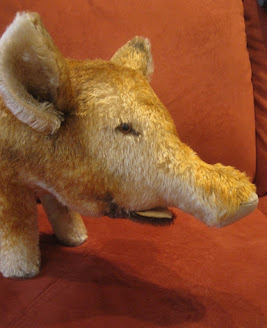So let's get cosy with Steiff's lovely Tosi! Tosi is standing, head jointed, and made from thick, lush, white wool plush. She measures 17 cm tall and 21 cm wide. Her simple, earnest face is detailed with a black glass button nose, brown and black glass pupil eyes, and a black hand embroidered nose. Other Tosi dogs Steiffgal knows of have soulful, almond shaped white, brown, and black eyes. It is her guess that Steiff probably used what eyes they had on hand at the time when producing her. Tosi's coat is in what is referred to as a "Karakul" trim, meaning that it is fluffy but uniformly the same length all over her body. She has a small, pert tail. Sadly, her red leather collar has been lost to time.
Overall, Tosi was produced in 14, 17, 22, and 28 cm in white or black from 1950 through 1953. Because of her time of manufacturer, her factory original IDs would have included a red-imprinted chest tag and a US Zone tag in her leg seam. Her ear button options could have included a short trailing "f" button, a blank button, a STEIFF all caps button, or even a raised script button. All of these different buttons have been noted on items from the very early 1950s.
Tosi was Steiff's debut postwar Poodle and her materials and form really reflect her time in the line. In terms of her fabric - she is made from wool plush. This material, which also appeared in the line on many standard line Steiff animals prewar, is often considered a wartime, transitional, or mohair substitute fabric. It is quite durable, with an old fashioned look and feel to it, and is good for toy making. In this case, given its fluffy, curly, thick consistency, it is a perfect fit for Tosi's Poodle particulars.
Although she debuted in 1950, Tosi's general presentation is more reflective of the late 1930s and early 1940s Steiff aesthetic. Products designed and produced during those tough years were often simplified, basic patterns with minimal jointing and as little decoration as possible. Some even had a seemingly "glum" or pensive presentation. All of this was a result of trying to be as efficient with materials, labor, and logistics as possible. Most likely, some of these same constraints were still in place early post war. Nonetheless, Steiff touted Tosi's introduction in its catalogs, even making her a cover girl in 1950. You can see this "glamour" shot here on the left.
Steiffgal hopes you enjoyed dipping your "Toe-si" into the story behind this pretty period Poodle!
Have a question about one of your Steiff treasures? Let's talk! Click here to learn more.





















